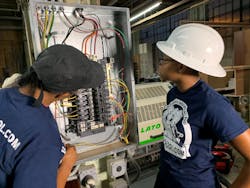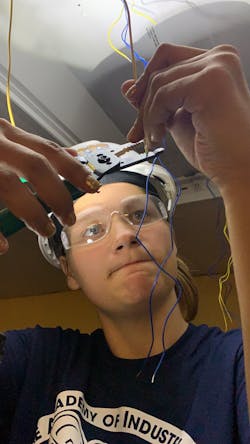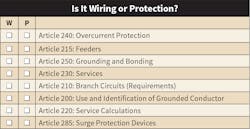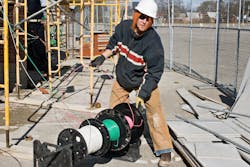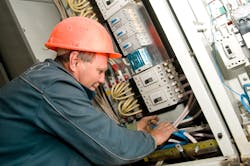Although the National Electrical Code (NEC) is the most significant publication for electrical installations in our industry, it’s also the most intimidating — especially to those new to the field. Published by the National Fire Protection Association (NFPA) and updated every three years, this resource is the “benchmark for safe electrical design, installation, and inspection to protect people and property from electrical hazards” for electrical professionals.
This article will provide electrical apprentices, seasoned journeymen, and electrical license test candidates with tips, tricks, and efficient ways to navigate the NEC, streamlining the process and saving you time, energy, and, most of all, stress. To kick things off, it’s important to realize that the most accurate and efficient way to interpret the NEC is to understand its unique language or technical terms embedded within every chapter. Therefore, if you can “word” associate these “unique” technical terms within the document’s nine chapters, you’ll be well on your way to mastering this vast publication. Note: This article is an excerpt from a live webinar previously presented on Aug. 30, 2021, which is still available on our website in an on-demand format at https://www.ecmweb.com/neca-show-coverage/webinar/21170830/the-nec-for-newbies.
Article 90: Introduction
When accessing the NEC, always keep in mind what the document is not. It’s not structured like a novel, it’s not an instruction guide for “untrained persons” or a design manual, and it will not give you step-by-step instructions on how to perform electrical installations. You can’t read it from cover to cover — you need a specific purpose before you start searching its pages.
Serving as an introduction to the Code, Article 90 stands alone in the NEC; it’s positioned ahead of all the chapters like a prelude. The language used in this Article explains explicitly “how” and “why” these guidelines for electrical installations are enforced.
This important section explains the purpose of the NEC; why the document exists, its scope, and its limitations; why, how, and who enforces its requirements (the power of Authorities Having Jurisdictions or AHJs); and who is involved with its creation, design, and evolution.
Unique terms or operative words specifically used in this Article include enforcement, special permission, AHJ, and mandatory/permissive rules.
Think of Figure 90.3 as an essential illustration at the beginning of your journey; this roadmap will show you how to navigate the NEC and provide some assistance in speeding your way through its layout. Here’s one thing most “newbies” to the electrical industry don’t understand: To master the Code and be proficient with its application, you do not have to memorize every single Chapter, Section, and Part. Obviously, it’s best to gain a thorough understanding of its language, but the first step in learning how to navigate the NEC is to understand its overall organization and layout. By adopting a structured approach to locating the information you seek, you’ll come to remember why each chapter exists. Then it will be easier to locate the information you’re looking for, save you time, and reduce frustration.
Marking up Figure 90.3 with purposeful “operative words” is the first effective trick I'll teach you to find information fast within the Code. It’s easier to manage if you break the entire book down into chunks. So, let’s start with Chapters 1-4.
Chapter 1: Definitions
In Chapter 1, you will find “General” Articles that apply to or affect all electrical installations from Chapters 1-9. For example, in Article 100, the NEC has technical terms alphabetically listed that define different types of electrical equipment, devices, or industry terms. Although any word used twice or more throughout the Code is in Article 100, “Definitions,” remember common words are not listed there. If you are unfamiliar with the electrical equipment referenced in several articles throughout the NEC, check Article 100 or the “definitions area” at the beginning of the Article right after “scope,” which covers the subject area you are researching. This technique is helpful if you're preparing for an examination as well. Several questions on electrical licensing tests come straight from Article 100.
Article 110: Requirements for Electrical Installations
Article 110 covers basic requirements that apply to “all electrical installations” and contains the tables for “working space” requirements. For example, this is where you find tables for the required width, height, and depth clearances around electrical equipment below 600V in Part 1 and above 600V in Part 2. Article 110 also covers general guidelines that stretch across all wiring method types. These are procedures for everyday routine tasks electricians perform in residential, commercial, or industrial installations, such as Sec. 110.12 “Mechanical Execution of Work.”
Chapter 2: Wiring and Protection
Chapter 2 is the go-to section of the NEC for electricians in search of guidelines and minimum requirements to wire up and power applications such as hotels, motels, and dormitories; residential homes (dwelling units); industrial facilities (hazardous locations); commercial buildings (special occupancies); and apartment buildings (multi-family dwellings).
Unique terms or operative words specifically used in Chapter 2 include: demand factor tables; sizing branch circuits and feeders; grounding and bonding requirements; (dwelling unit) branch-circuit requirements; calculations for service feeders and conductors; and sizing/selecting overcurrent protective devices.
Don't be intimidated. It's easy to remember the purpose of Chapter 2 because it divides content across two sides: the “wiring”-related side and the “protection”-related side.
Understanding which side each Article fits on will get you on your way to associating guidelines that specifically come from Chapter 2. Keep in mind: Some of these Articles fall on both sides of Chapter 2. Can you figure out which ones apply to both sides?
Here’s an example. Does Sec. 210.4 (B) “Disconnecting Means” fall on the wiring side, protection side, or both? Practicing this exercise will help you make sense of the title of Chapter 2, as well as how the Articles are strategically placed within it. Go through Chapter 2, and assign each Article to a specific side or both. Eventually, you'll get the hang of it, memorizing where each Article is located within the Code organically (See Figure below).
Chapter 3: Wiring Methods and Materials
This is one of the most critical chapters in the NEC. Your journey in mastering the navigation of the Code includes the crucial Articles within Chapter 3 — these provide electricians with the minimum guidelines used during the “building stage” of an electrical construction project. These Articles will be your go to for selecting intervals and means of support for cables and raceways; types, style, and design of junction boxes and pull boxes; and materials/equipment to be used throughout the construction process.
Non-metallic sheathed cable, mineral-clad cable, and Type UF cable are all wiring methods. In addition, we use specific materials to protect conductors (rigid metal conduit or RMC, electrical metallic conduit or EMT, and rigid PVC conduit), which are also wiring methods. Basically, just remember this: If you can bend it (Photo 1), pull it (Photo 2), or terminate it (Photo 3), it’s in Chapter 3.
If you focus on the structure and layout of Chapter 3, you’ll be answering common questions that come up on the job site every day, such as:
- How often are you required to support EMT conduit?
- How many #14 AWG conductors can I put in a 4-in. × 2⅛-in. square metallic junction box?
Chapter 4: Equipment for General Use
Don't be confused with grasping the purpose of Chapter 4. It encompasses installation guidelines for everyday general stuff like motors, appliances, switchgear, receptacles, air conditioning equipment, and luminaires (a fancy word for light fixtures).
The guidelines are neatly organized in Article(s) 400 through 490. Chapter 4 is vast but easy to navigate. Remember: If the equipment utilizes electrical power and is something you generally "see" or "use" every day in a home, business, or factory, it's in the “Equipment for General Use” section of the Code.
Just because you’re not experienced installing motors or answering motor exam questions, for example, don't be intimidated by Art. 430. There’s an illustrated directory at the beginning (Figure 430.1) that leads you through the whole Article. This convenient directory lays out a complete motor circuit from top to bottom; you can go straight to the circuit section in the diagram, and find the article reference covering the information you seek. This time-saving tip will help you answer common questions on the job site with lightning-fast speed (e.g., how to size a feeder for a single or multiple motors).
You can also find Article references to answer typical questions found on most master electrician or journeyman examinations, such as:
- What is the maximum sizing for branch-circuit, short-circuit, and ground fault protection devices?
- What is the maximum sizing for motor overload protection devices?
- How do you determine the sizing and rating of motor disconnects?
Mastering the Index
When seeking information within the NEC, the index in the back is the fastest way to find the Article, Section, and Part covering a particular installation guideline. The index is neatly organized alphabetically from A-Z by main topics, which I like to call “keywords” or “operative words.”
Start your search in the index using a word that best describes or defines the main topic of the subject matter you seek. This step will get you on the right “block.” The index will then list "sub-topics" by Article references for the subsections or branches of that main topic. This will essentially get you to the right house on the right block. Check every reference until you find the guideline you were seeking.
The index is easy to use when narrowing down the main topic in one word. My advice is to get tabs for your Code book and alphabetical tabs (A-Z) for your NEC index. These inexpensive tools will mark the most commonly referenced sections of the NEC and areas of an exam in which you need to focus most. By completing this simple step, you’ll not only save valuable time on the job site, but when the boss asks you a question, you'll also finally be able to give him or her a Code-based answer.
Harold De Loach, a master electrician and electrical trainer/instructor, is the founder of The Academy of Industrial Arts in Philadelphia. He is also the director of education and training for www.necprepclass.com, which provides electrical license preparation courses for the city of Philadelphia and the Lehigh Valley Allentown, Pa., areas. With more than 30 years of experience in the field, he writes regular exclusive content for the E-Train newsletter and can be reached at [email protected].

